Nike, ambassador of contemporary Nigerian art.
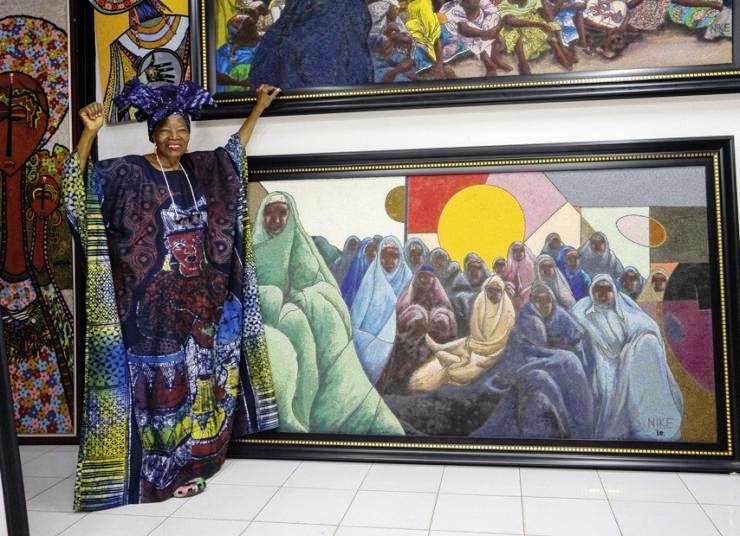
Recycled material reigns supreme in Nike’s modern art galleries in Lagos and Abuja. It brings together, on crowded walls, sculptures, textiles, jewellery, amulets and paintings that lay claim
to another Nigeria.
It’s not easy to keep up with Nike Okundaye, founder of the Nike Art Gallery art centres in Lagos, Abuja, Òsogbo and Ogídi-Ìjúmi. Known as Mama Nike, she arrives with her four daughters in a very small van decorated with striking colours and photographs. As you enter the gallery in Lagos, you are welcomed by animal sculptures inspired by real creatures and others from the artists’ imagination. They share the space with signs announcing workshops, cultural activities and city tours in which Nike’s seemingly inexhaustible energy takes centre stage.
Smiling, welcoming and overwhelming, Nike takes several questions that she barely has time to answer to quickly classify her interviewer. As she affectionately greets the employees and artists in training, she heads towards the large door leading to a multi-storey gallery whose centre is occupied by panels that share the available space.
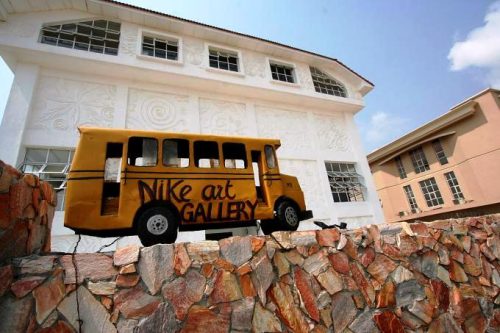
Nike Art Gallery, Lagos. CC BY 2.0/Jeremy Weate
The walls are covered with paintings. The floor is also a space covered with contemporary art pieces that occupy enormous tables on which piles of drawings must be unpacked in order to appreciate them. “From rubbish to treasure, from waste to wealth”, is how Nike defines her works, made largely with recycled materials, a technique in which the African continent is a true master.
“We use wax to make large jewels, even animal remains that speak of Nigerian tradition, or wood to make other traditional jewels that can be used to decorate the wall, for those who prefer not to hang up painting,” Nike continues. She stops just long enough to show what she is explaining, but without lingering too much, aware of the enormous work she has managed to concentrate on in the gallery. Her aim is to cover as much as possible and offers her personal attention to each artist, telling how they arrived at that point in their creation, their maturation process and the meaning of shapes and colours.
Nike’s work
“My work focuses on coloured balls and glue. I like to make things that people can wear, for example, the hats I design. We give some pieces a coloured patina to make them look older,” explains Nike, interpreting the genre with unwaning enthusiasm. In the area of textiles, with blue and indigo fabrics printed with geometric figures, you can see another of her best-known techniques. “When we wear a tunic or a certain dress, we are saying something about ourselves”, she says, passing her hand over the garments hanging in the exhibition area.
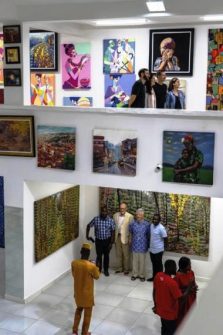
Visitors at the Nike Art Gallery in Lagos. Photo: Carla Fibla García-Sala
Nike comes from a childhood marked by poverty and the loss of her mother. At the age of 16, she left home and went to live with the artistic community of Òsogbo and a year later she participated in her first exhibition organized by the Goethe Institute. Six years later she managed to study sewing at the Haystack Mountain School of Crafts (USA) and in 1981 she won first prize at the Southwest Washington Art Festival. Subsequently, recognition came from London and the UN, which in 1994 chose her among the 50 artists selected worldwide to show their work in a documentary on the occasion of the fiftieth anniversary of the organization.
Creating community
She began sharing her knowledge with her first arts and culture centre which opened in Òsogbo in 1983. Almost 20 years later she did the same in Abuja, the capital, and in 2009 in Lagos. In 1996, she moved to the economic capital of the country and created the Textile and Sewing Center in Ogídi-Ìjúmi (Kogi State), which became her first training workshop. “I’ve always been obsessed with girls’ independence, but how to reach it? We managed to convince schools from 36 states to regularly send us 150 girls so that, while spending two months at the Òsogbo centre, they discover their skills and begin to develop them”, she proudly explains, still showing pieces made by some of the young women who passed through their workshops. Despite being well-known, Nike does not seem to have lost touch with the reality of her people, with the poverty and unemployment that afflict her country, conditions that she tries to show and, in part, remedy through art.
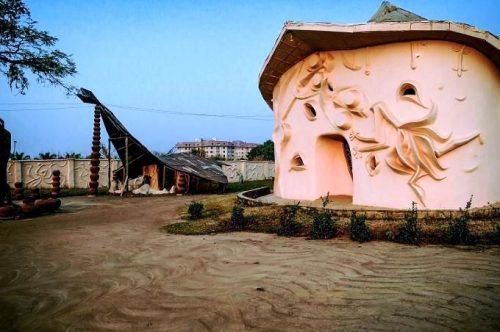
Nike art gallery, Abuja. CC BY-SA 4.0/Turizimpressions
In addition to public relations and monitoring artists in training, Nike dedicates several hours a day to developing their talents. Now in her eighth decade of life, her capacity for inspiration still remains intact. “You learn by trying to imitate, it’s the way to create your own style. This work – she says, indicating the face of a restless child – seems to say: ‘When I grow up, I want to be like you’, but when you look at it you only see a child. Yes, but the child tells you something.”
The reflections she offers while walking through the Lagos gallery leave no loose ends: “All these drawings are like communication by telephone… Here it is the barbed wire, the bamboo that unites us. It’s the cycle of life. The child is born, grows and becomes an adult. And that same child takes care of the one who took care of him or her as a child.”
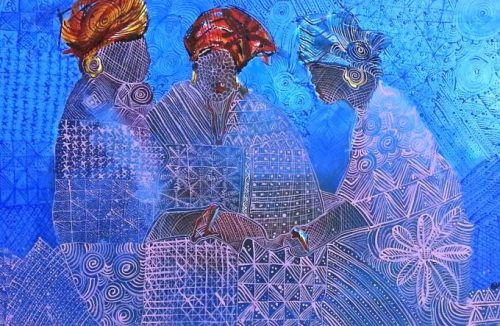
“Art relaxes people, it’s very important because it has a healing component. You look at a work and feel a certain emotion, sometimes joy.” Photo: Nike Art Gallery
We pass in front of a work of hers which she playfully shows us, explaining that she needed to draw an aeroplane and convey what you feel when you get on board, which is why the painting is full of farewell words and good wishes for the journey. “There is this comparison in contemporary art between old and new creations, but we must focus on young artists because they are the ones who can give the most.”
Nike claims that visiting her art galleries is “a therapy” in which the most important thing is to look at the works and stop at the most evocative part of each one, trying to understand them and thinking about what would be going through the mind of the artist when he or she created them or draws conclusions whose understanding at times cannot be shared. “Art relaxes people, it’s very important because it has a healing component. You look at a work and feel a certain emotion, sometimes joy.”Although it is difficult to choose a technique or material to define current Nigerian contemporary art, Nike highlights the use of bronze, the application of wax – whose origin is in Benin City – and creativity in the textile sector “because it’s what’s attached to your skin, something very important and that’s why I started focusing on the designs we capture on fabrics, the meaning of the symbols we use. And that’s what I’m still dedicated to,” Nike concludes. (Nike Okundaye, founder of the Nike Art Gallery art Centre in Lagos. Photo:Carla Fibla García-Sala)
Carla Fibla García-Sala



